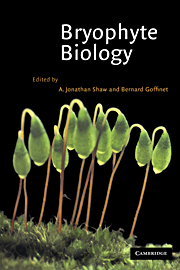Book contents
- Frontmatter
- Contents
- List of contributors
- Preface
- 1 Anatomy, development, and classification of hornworts
- 2 Morphology and classification of the Marchantiophyta
- 3 Morphology and classification of mosses
- 4 Origin and phylogenetic relationships of bryophytes
- 5 Chemical constituents and biochemistry
- 6 Molecular genetic studies of moss species
- 7 Control of morphogenesis in bryophytes
- 8 Physiological ecology
- 9 Mineral nutrition, substratum ecology, and pollution
- 10 Peatlands: ecosystems dominated by bryophytes
- 11 Role of bryophyte-dominated ecosystems in the global carbon budget
- 12 Population ecology, population genetics, and microevolution
- 13 Bryogeography and conservation of bryophytes
- Index
3 - Morphology and classification of mosses
Published online by Cambridge University Press: 05 June 2012
- Frontmatter
- Contents
- List of contributors
- Preface
- 1 Anatomy, development, and classification of hornworts
- 2 Morphology and classification of the Marchantiophyta
- 3 Morphology and classification of mosses
- 4 Origin and phylogenetic relationships of bryophytes
- 5 Chemical constituents and biochemistry
- 6 Molecular genetic studies of moss species
- 7 Control of morphogenesis in bryophytes
- 8 Physiological ecology
- 9 Mineral nutrition, substratum ecology, and pollution
- 10 Peatlands: ecosystems dominated by bryophytes
- 11 Role of bryophyte-dominated ecosystems in the global carbon budget
- 12 Population ecology, population genetics, and microevolution
- 13 Bryogeography and conservation of bryophytes
- Index
Summary
Introduction
Bryophytes, in the broad sense, are the second largest phylum of land plants, after the angiosperms, and inhabit every continent. Among the bryophytes, mosses (the Bryophyta sensu stricto) are the most speciose group, comprising approximately 10000 or more species. They differ from liverworts and hornworts in a suite of characters (see chapters 1,2), including macroscopic features such as a gametophyte composed of stems with undivided and often costate leaves that are typically arranged all around the axis, and a sporophyte terminated by a capsule that is elevated by the elongation of a seta prior to maturity, and whose mouth is lined by teeth involved in regulating the dispersal of spores. Mosses along with liverworts and hornworts represent the oldest lineages among extant land plants (chapter 5 in this volume). Evidence is mounting that mosses are currently at the highest level of diversity in their evolutionary history (e.g., Kürschner & Parolly 1999). This rather recent diversification of mosses is likely correlated with the advent of angiospermous forests which provide a wide array of habitats. This trend is best exemplified in tropical rainforests, where most of the diversity in mosses is found.
Although mosses are rather small organisms, their morphology is relatively complex. Macroscopic characters are limited and most taxonomic concepts rely on features of the cells composing individual tissues. Throughout their evolutionary history, mosses have undergone repeated morphological reduction and simplification (Frey 1981), often as a result of colonizing specialized, and particularly xeric or ephemeral habitats (Vitt 1981).
- Type
- Chapter
- Information
- Bryophyte Biology , pp. 71 - 123Publisher: Cambridge University PressPrint publication year: 2000
- 72
- Cited by



